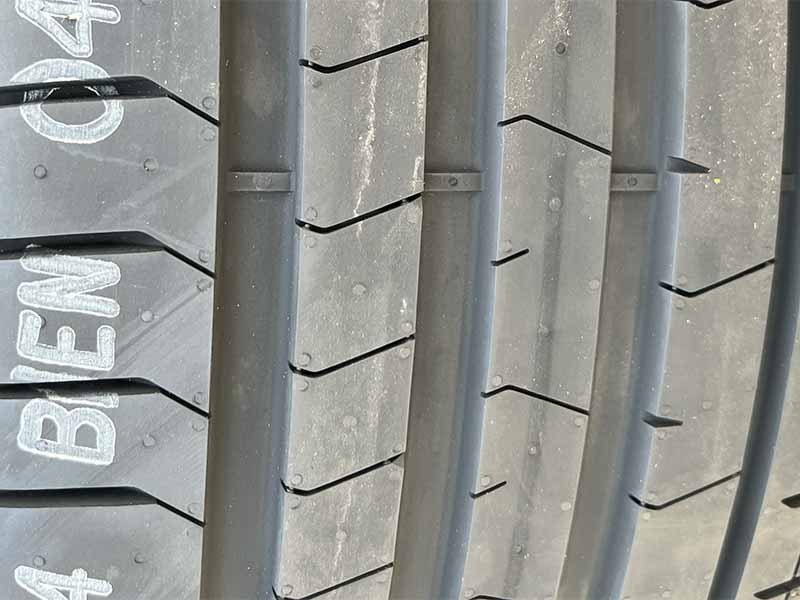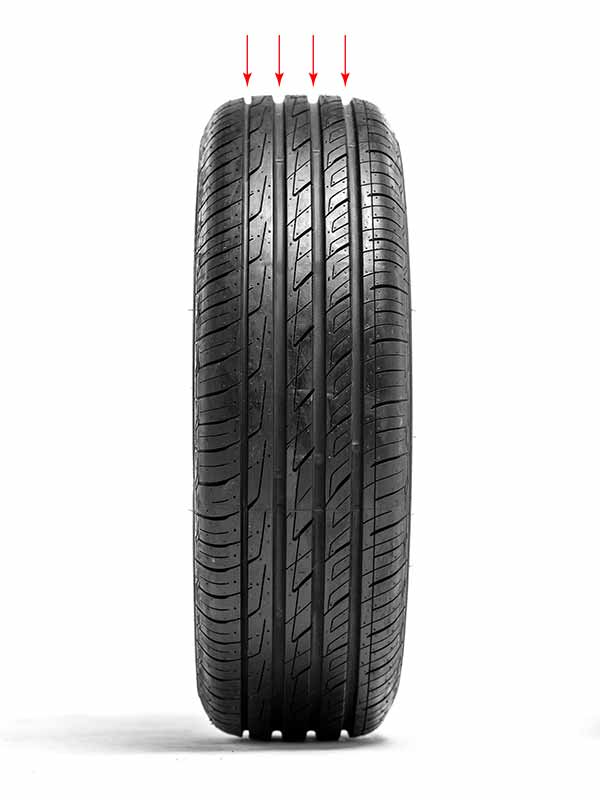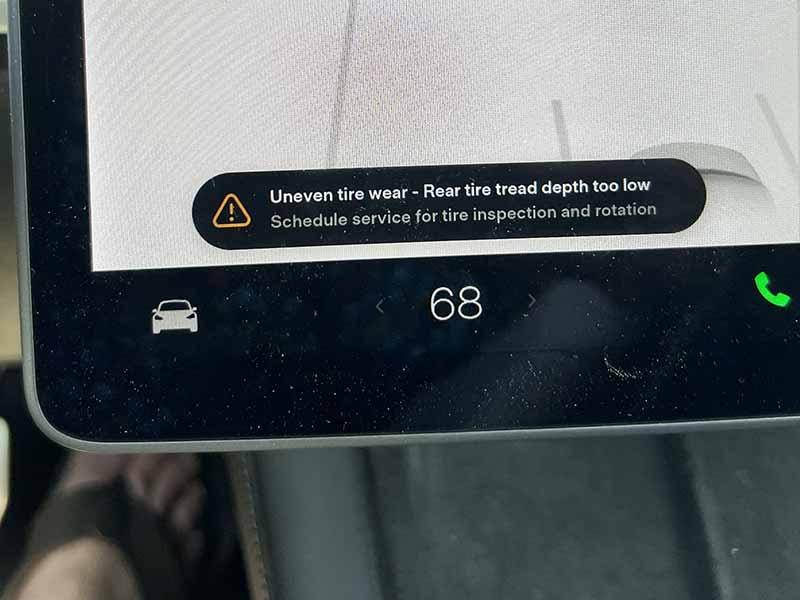It can be a little confusing to know exactly how safe different tread depths are and what your tire tread depths should be.
While it’s obvious that if you only have 2/32″ of tread left you should replace your tires because they’re considered bald, you probably should consider replacing your tires before they reach that low tread depth.
What Is A Good Tire Tread Depth?
A good tire tread depth is 5/32″ or greater. Tires with 4/32″ or less depth are recommended to be replaced. Once tires reach 2/32″ they are considered bald must be replaced for your safety.
Stopping distance on wet roads increases as tread depth decreases. The risk of hydroplaning also increases.
A tire tread depth gauge is the best way to measure the depth of your tread, but it isn’t the only way to determine if your tire should be replaced.
It’s also important to understand how a worn tire affects traction and safety. Safe driving and avoiding higher speeds are important, but a good grip of the tire rubber on the pavement is just as important.
Let’s take a closer look.
Tire Tread Depth Chart
What Is A Safe Tread Depth?
Safe tread depth for tires is 5/32″ or greater. As a tire’s tread depth drops below this point, stopping distances become significantly longer than those of new tires, and the risk of hydroplaning becomes greater.
Stopping Distance On Wet Roads
In wet conditions, deeper tread grooves are better able to channel water out from under and away from the tire’s contact patch. This allows your tires to maintain traction and stop more quickly on wet surfaces.
As your tire’s tread wears down, the grooves become shallower and it slowly becomes more difficult for water to escape from underneath the tires. Over time, your tire performance on wet roads reduces and your stopping distances will become longer.
New tires can wear down 1/32″ and stopping distances will increase very slightly. As your tire tread wears further, each 1/32″ of wear increases stopping distances more and more.
Also, the difference in 1/32″ of tread wear when a tire is new is small. When very worn tires lose 1/32″, the difference is much greater and will dramatically increase the stopping distance.
How To Avoid Hydroplaning
While it is true that tread depth has a big effect on the risk of hydroplaning, the more significant cause of hydroplaning is speed.
The best way to avoid hydroplaning is to drive more slowly in rainy weather. Avoid standing water and keep more distance between you and the vehicle in front of you.
Even new tires can hydroplane at high speeds. Lower tread depths will make hydroplaning more likely, but tread depth alone can’t prevent your car or truck from hydroplaning.
New Tire Tread Depth
New tires typically have 11/32″ to 10/32″ tread depth. This is true for most traditional all-season tires and summer tires found on light trucks and passenger cars with tires designed for on-road use.
Winter tires and off-road tires usually have more tread depth and will have different minimum tread depth requirements. Winter tires, for instance, should have at least 5/32″ of tread depth to ensure they can grip properly in snow and slush.

How To Measure Tread Depth
There are a few common methods used to measure tread depth. The most accurate is to use a tread depth gauge, but you may not have one handy.
A more convenient method is to use a penny or a quarter to check your tread depth. You can also usually find wear bars in the deep tread groove next to the main tread ribs which you can use as a reference.
How To Use A Tire Tread Depth Gauge
Most tread depth gauges use a metal probe inserted into the main grooves of your tire’s tread. The gauge is pressed down until the shoulders of the probe rest on the top of the tread blocks and the probe tip rests at the bottom of the tread groove.
You can then remove the gauge from the top of the tire tread and read the measurement.
Plunger-Style Tread Depth Gauge Example
How To Measure Tread Depth With A Coin
There are different coins that can be used to measure tread depth, but a penny or Washington quarter are the best choices.
Penny Test
The penny test is performed by inserting a penny upside down into one of the main tread grooves. With Lincoln’s head upside down, you can compare the top of the tire tread with the position on Lincoln’s head.
- If the top of the tread reaches Lincoln’s forehead or more, you have enough tire tread.
- If it reaches between Lincoln’s forehead and the top of Lincoln’s head, you should consider replacing your tires soon.
- If the top of the tread doesn’t reach the top of Lincoln’s head, your tires should be replaced immediately.
Quarter Test
The quarter test is performed by inserting a Washington quarter upside down into one of the main tread grooves. With Washington’s head upside down, you can compare the top of the tire tread with the position on Washington’s head.
- If the top of the tread reaches past the top of Washington’s head or more, you have enough tire tread.
- If the top of the tread doesn’t reach the top of Washington’s head, your tires should be replaced soon.
How To Read Wear Bars On Tires
Most tires have a built-in tread wear indicator. Wear bars are raised sections deep in the main grooves of your tires. These bars are raised exactly 2/32″ to match the minimum legal tread depth.
Once your tire’s tread wears down to even with the top of the tread wear indicator bars, it’s time to replace your tires.

Where To Measure Tire Tread Depth
All tire tread measurements should be taken from one of the main grooves. Smaller grooves or sipes in your tread patterns may not extend as deep or may be too narrow to get an accurate reading.
The goal is to get a vertical measurement from the deepest groove to the top of the tread block to get the proper measurement.
You should take measurements at multiple points around your tire’s tread. This includes the entire width and circumference. This will help you detect uneven tread wear and find the lower tread depths.

Tread Depth To Replace Tires
When a tire’s tread reaches 4/32″ it’s time to consider tire replacement. Tread wear down to this level gives very little room between the tread blocks to allow water to flow out from under the contact patch in wet conditions.
This is well above the minimum tread depth but still quite low and will have allowed you to get the majority of the value out of your new tires.
Pushing to a depth of 3/32″ is not unreasonable but you are reducing the safety margin in rainy conditions even further.
When tread wear reaches 2/32″ it is legal time to replace tires. At this point there is precious little left of the tread groove and water can only escape from underneath the contact patch in the mildest of wet weather conditions.
Risks of hydroplaning are very high at this level and stopping distances will have become dramatically longer than those of new tires.
What Is The Minimum Tread Depth For Front Tires Vs Rear Tires?
The minimum tread depth for front tires of passenger cars and light trucks is 2/32″. This is the same for the rear tires as well.
The minimum tread depth for front tires on semi-truck tractors is 4/32″, while the other tires can have 2/32″ of remaining tread wear.
Passenger cars and trucks shouldn’t follow this rule since they don’t have the same number of axles. Vehicles with only 2 axles should have the best tires in the rear to prevent oversteering in wet weather conditions.
This may seem counterintuitive since the front tires take the brunt of steering and braking traction and performance. While this is true, the issues with losing traction at the front axle versus the rear axle make it the safer choice.
Understeer is easier to control than oversteer when your wheels lose traction on wet surfaces. When buying new tires, they should always be installed on the rear to ensure safe handling performance on wet surfaces.

Resources
Below are some links you may find helpful when learning about tires
Final Thoughts
Good tread wear levels are important to safe driving and ensuring your tire’s rubber can maintain traction and contact with wet pavement.
If your tires are worn or uneven treadwear has caused some areas of your tire to have very little tread left, your tire should be replaced.
It’s important for you to understand what the effects of tire wear are so you can make an informed decision about when to replace your tires.
Good luck and happy motoring.







